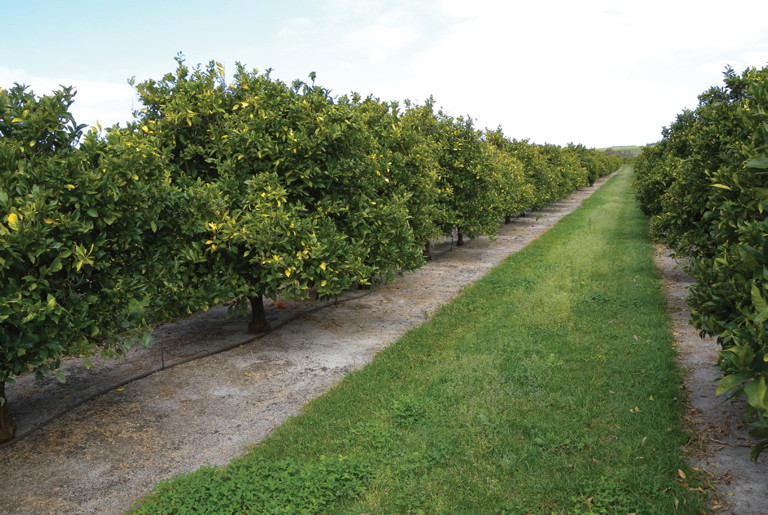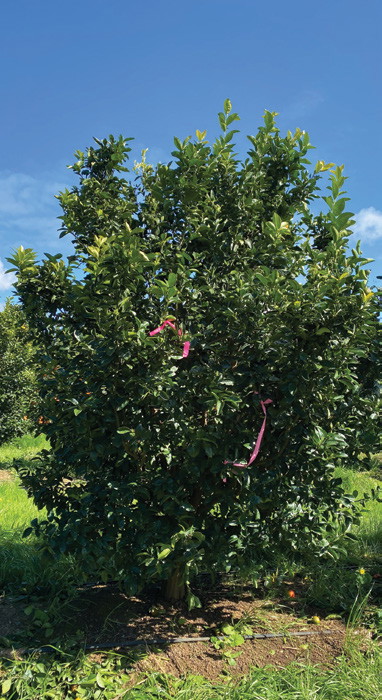
Pruning
after
harvest
PRUNING allows for easier harvest by workers or access to machinery.

BY ELBE COETSEE
INDUSTRY
DEVELOPMENT OFFICER,
WA CITRUS
Pruning is essential after harvest and before bud break as it sets your trees up for the next growing season. Past this statement it becomes more complicated and can be a highly topical subject on the ‘what to prune’ and frustrating finding time to fit it into a busy schedule.
Getting to the heart of the matter is, why are you pruning and keeping an eye on what your orchard needs in the longer-term and your resources of time and money.
The following is some general principles of pruning, followed by some recommended reading or watching to get the higher level of detail you may be chasing.
Why should I prune?
The reasons for pruning may depend on the age of your orchard, how it’s been treated in the past, and your yields and fruit quality from previous seasons.
Generally speaking, the primary reason for pruning is creating and maintaining a good frame that increases light penetration and airflow through the canopy. Light is the key to new shoot growth (for flowers and fruit) sugar and colour development, and reducing albedo breakdown. Airflow means that foliar sprays reach their target such as fruit within the canopy, and pests and diseases. Getting these two factors right will mean good yields and quality. Related to yields, pruning is used for managing alternate bearing in mandarin varieties, and is being investigated for overcoming yield decline in Afourer mandarins as part of a Hort Innovation project (CT19002).
The second reason for pruning is general health of the canopy as pruning removes old, dead, and diseased wood and managing regrowth e.g., water shoots and rootstock shoots.
Skirting keeps the bottoms of the tree off the ground, which in turns reduce access for pests, prevent fruit from touching the soil, and improves fertiliser and irrigation spread.
Lastly pruning is about access to the trees. Pruning allows for easier harvest by workers or access to machinery. Keeping trees a manageable size, especially in relation to height and related use of ladders. This decision however should be based on a review of financials to also account for the proportion of yield that will be foregone with the loss of tree size.
Pruning removes old, dead, and diseased wood.

Use clean, sharp equipment to prevent wounds in the tree becoming diseased.

PRUNING is a big expense due to the labour involvement, but done right, it has big returns.
Can you cut away too much or too little?
Cutting away too much canopy can expose bark and internal fruit to sunburn, reduce your crop and remove the leaves, which are the ‘food factory’ of the tree. Pruning too little has its own disadvantages. Trees become too dense or too big and the crop load and fruit quality can be reduced from lack of light and scratching etc. The amount that is pruned affects the time and therefore cost per tree on pruning.
A regular pruning activity each year keeps trees in good condition and is recommended.
Growers rotate the focus of the pruning, for example, water shoots in one year followed by major pruning, then minor pruning to manage the cost while still managing the canopy.
In his video, Steven Falivene explains “you’re looking to create dappled light through the canopy rather than strong light”. The ‘Window’ pruning technique, is where ‘a section’ of the tree is annually pruned out. This is nicely demonstrated by Darren Minter, a citrus grower from Sunraysia. Pruning approximately 20% of the canopy achieves a 5 year turn around and does not unbalance the tree.
Equipment
Using clean and sharp equipment prevents wounds in the tree that can become diseased, and prevent the spread of disease. Sterilising can be done with a freshly-mixed spray or dip of ‘one part chlorine bleach plus two parts of clean water’ can be used. Oil instruments after use to prevent rusting and corrosion.
Is pruning worth doing?
Pruning is a big expense due to the labour involvement, but done right, it has big returns. A case study showed good hand pruning returned a three-fold increase on returns.
An experienced pruning team or staff member can reduce the time factor of inexperienced pruners spending time trying to decide what branches to cut out.
To help growers decide on the costbenefits of pruning, NSW DPI has conducted a cost benefit analysis and created an excel spreadsheet. This analysis takes into account costs of mechanical pruning, hand pruning and the returns expected from increased quality of fruit.

THE primary reason for pruning is creating and maintaining a good frame that increases light penetration and airflow through the canopy.
MORE INFORMATION
• Online at agric.wa.gov.au/citrus/citruspruning
• Grower Darren Minter explains his pruning technique: dpi.nsw.gov.au/agriculture/horticulture/citrus/content/ canopy-management/navel-orangepruning/darren-minter-citrus-growerpruning-videos
• NSW DPI canopy management citrusaustralia.com.au/news/latestnews/economics-of-pruning-quicklyadd-up
• Hort Innovation project Afourer mandarin best practice canopy management (CT19002) horticulture.com.au/growers/help-your-business-grow/researchreports-publications-fact-sheetsand-more/ct19002/ Contact Rachelle Johnstone at DPIRD in WA via the DPIRD website www.wa.gov.au/organisation/department-of-primary-industries-andregional-development